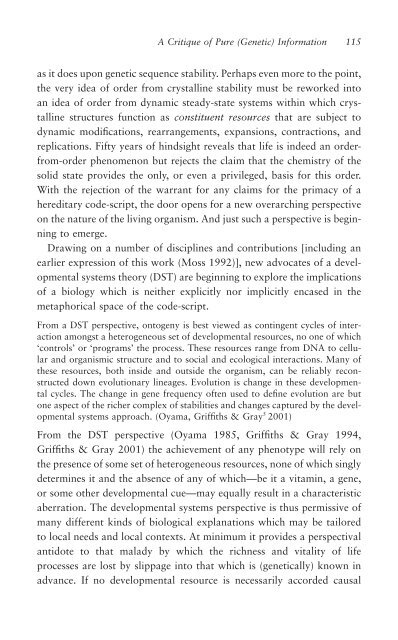A Critique of Pure (Genetic) Information
A Critique of Pure (Genetic) Information
A Critique of Pure (Genetic) Information
Create successful ePaper yourself
Turn your PDF publications into a flip-book with our unique Google optimized e-Paper software.
A <strong>Critique</strong> <strong>of</strong> <strong>Pure</strong> (<strong>Genetic</strong>) <strong>Information</strong> 115<br />
as it does upon genetic sequence stability. Perhaps even more to the point,<br />
the very idea <strong>of</strong> order from crystalline stability must be reworked into<br />
an idea <strong>of</strong> order from dynamic steady-state systems within which crystalline<br />
structures function as constituent resources that are subject to<br />
dynamic modifications, rearrangements, expansions, contractions, and<br />
replications. Fifty years <strong>of</strong> hindsight reveals that life is indeed an orderfrom-order<br />
phenomenon but rejects the claim that the chemistry <strong>of</strong> the<br />
solid state provides the only, or even a privileged, basis for this order.<br />
With the rejection <strong>of</strong> the warrant for any claims for the primacy <strong>of</strong> a<br />
hereditary code-script, the door opens for a new overarching perspective<br />
on the nature <strong>of</strong> the living organism. And just such a perspective is beginning<br />
to emerge.<br />
Drawing on a number <strong>of</strong> disciplines and contributions [including an<br />
earlier expression <strong>of</strong> this work (Moss 1992)], new advocates <strong>of</strong> a developmental<br />
systems theory (DST) are beginning to explore the implications<br />
<strong>of</strong> a biology which is neither explicitly nor implicitly encased in the<br />
metaphorical space <strong>of</strong> the code-script.<br />
From a DST perspective, ontogeny is best viewed as contingent cycles <strong>of</strong> interaction<br />
amongst a heterogeneous set <strong>of</strong> developmental resources, no one <strong>of</strong> which<br />
‘controls’ or ‘programs’ the process. These resources range from DNA to cellular<br />
and organismic structure and to social and ecological interactions. Many <strong>of</strong><br />
these resources, both inside and outside the organism, can be reliably reconstructed<br />
down evolutionary lineages. Evolution is change in these developmental<br />
cycles. The change in gene frequency <strong>of</strong>ten used to define evolution are but<br />
one aspect <strong>of</strong> the richer complex <strong>of</strong> stabilities and changes captured by the developmental<br />
systems approach. (Oyama, Griffiths & Gray 5 2001)<br />
From the DST perspective (Oyama 1985, Griffiths & Gray 1994,<br />
Griffiths & Gray 2001) the achievement <strong>of</strong> any phenotype will rely on<br />
the presence <strong>of</strong> some set <strong>of</strong> heterogeneous resources, none <strong>of</strong> which singly<br />
determines it and the absence <strong>of</strong> any <strong>of</strong> which—be it a vitamin, a gene,<br />
or some other developmental cue—may equally result in a characteristic<br />
aberration. The developmental systems perspective is thus permissive <strong>of</strong><br />
many different kinds <strong>of</strong> biological explanations which may be tailored<br />
to local needs and local contexts. At minimum it provides a perspectival<br />
antidote to that malady by which the richness and vitality <strong>of</strong> life<br />
processes are lost by slippage into that which is (genetically) known in<br />
advance. If no developmental resource is necessarily accorded causal
















